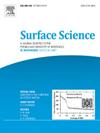Adsorption of ethyl ether on graphene/silicon – Theory and experiment
IF 1.8
4区 化学
Q3 CHEMISTRY, PHYSICAL
引用次数: 0
Abstract
Adsorption of ethyl ether, CH3CH2–O–CH2CH3 (or C4H10O or (CH3CH2)2O), on graphene/Si(111) (hereafter Gr/Si(111)) was characterized by kinetics (multi-mass thermal desorption spectroscopy (TDS), steady-state rate measurements) and spectroscopic (Auger electron spectroscopy (AES), X-ray photoelectron spectroscopy (XPS), Raman spectroscopy) techniques as well as by density functional theory calculations (DFT) as a potential metal-free catalyst. TDS results agree with the expected fragmentation pattern of molecular ethyl ether. AES and XPS spectra collected after ethyl ether adsorption are identical with data for pristine Gr/Si(111). Therefore, ethyl ether adsorbs molecularly, consistent with large activation energies for dissociation calculated by the DFT.

乙醚在石墨烯/硅上的吸附——理论与实验
通过动力学(多质量热解吸光谱(TDS)、稳态速率测量)、光谱(埃格电子能谱(AES)、x射线光电子能谱(XPS)、拉曼光谱)技术以及密度泛函理论计算(DFT),表征了乙醚CH3CH2 - o - ch2ch3(或C4H10O或(CH3CH2)2O)在石墨烯/Si(111)(以下简称Gr/Si(111))上作为潜在无金属催化剂的吸附特性。TDS结果与预期的乙醚分子断裂模式一致。乙醚吸附后收集的AES和XPS光谱与原始Gr/Si(111)的数据一致。因此,乙醚在分子上吸附,这与DFT计算的解离活化能大一致。
本文章由计算机程序翻译,如有差异,请以英文原文为准。
求助全文
约1分钟内获得全文
求助全文
来源期刊

Surface Science
化学-物理:凝聚态物理
CiteScore
3.30
自引率
5.30%
发文量
137
审稿时长
25 days
期刊介绍:
Surface Science is devoted to elucidating the fundamental aspects of chemistry and physics occurring at a wide range of surfaces and interfaces and to disseminating this knowledge fast. The journal welcomes a broad spectrum of topics, including but not limited to:
• model systems (e.g. in Ultra High Vacuum) under well-controlled reactive conditions
• nanoscale science and engineering, including manipulation of matter at the atomic/molecular scale and assembly phenomena
• reactivity of surfaces as related to various applied areas including heterogeneous catalysis, chemistry at electrified interfaces, and semiconductors functionalization
• phenomena at interfaces relevant to energy storage and conversion, and fuels production and utilization
• surface reactivity for environmental protection and pollution remediation
• interactions at surfaces of soft matter, including polymers and biomaterials.
Both experimental and theoretical work, including modeling, is within the scope of the journal. Work published in Surface Science reaches a wide readership, from chemistry and physics to biology and materials science and engineering, providing an excellent forum for cross-fertilization of ideas and broad dissemination of scientific discoveries.
 求助内容:
求助内容: 应助结果提醒方式:
应助结果提醒方式:


